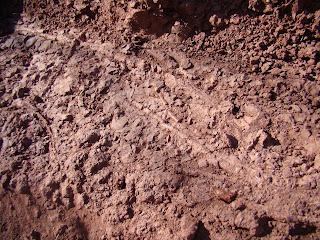 Chris and Kathy work on excavating two separate layers at the Amy site early this morning. The lower level contains the associated Dimetrodon skeleton discovered yesterday.
Chris and Kathy work on excavating two separate layers at the Amy site early this morning. The lower level contains the associated Dimetrodon skeleton discovered yesterday. A close up of the lower level of the Amy site. Dimetrodon fin spines extend from the bottom right of this image to the top left, with ribs and additional fin bones crossing them from a different direction. Only the right half of this layer was visible yesterday. Soon, they'll have to start excavating from the top of the hill in order to avoid a collapse. Dr. Bakker estimates this skeleton will take at least 16 people days to completely remove from the site.
Chris maps the bones on clear plastic as they are uncovered. Since even photographs can skew the direction of the bones slightly from their true location, this technique ensures accurate measurements, even after the bones have been removed from the site.

Close up of the bone maps. Later, they'll be digitized for analysis.
The team also investigated a mystery tooth that kept popping up - 4 times in all before they figured out what is was. Neal found the first one yesterday - a tiny, tiny tooth with microserration - visible only under magnification - that was much more delicate than any other tooth found at the site. 3 more were found this morning, including one about 190 mm above the main Dimetrodon layer at the Amy site. Then, we found this at the K2 site today:
"Look at that fang!" Dr. Bakker found this tooth in 2 pieces at the lower level of the K2 site, where the Diadectes vertebra was discovered on Monday. It's much sharper, more fluted and has a finer saw edge than most Dimetrodon teeth, and it has very fine serration on both sides. It was located close to the front of the jaw and would have created a very different kind of wound.
This is a shed tooth from an adult Dimetrodon loomisi - "the cheetah of Dimetrodons" according to Dr. Bakker. While most larger Dimetrodon were chunky, this one was graceful. Still, it was a "big, honkin' carnivore," and the tooth looks very similar to that of a saber-tooth cat. From the adult tooth, Dr. Bakker identified the tiny mystery teeth the team had found were actually the juvenile versions of this species.
So, no brand new species - but, a new type of Dimetrodon is now known to be present at this site. And - it was eating Diadectes - more CSI evidence of the Permian ecology. "We found a bullet, literally mm from where the Diadectes veretebra came out. This is pretty intimate crime scene documentation. We've got six other bullets in this area. But this one (loomisi) is more like a sniper bullet, or a rifle bullet. Dimetrodon grandis was more like a .45."
Dr. Bakker also revealed another set of Dimetrodon spines at another layer in the Amy site - bringing the total number of discrete layers in this one hillside to 6. "What we're looking for is the next thing - no matter what it is. We're interested in everything, so we can figure out the context of what was happening here."
New Dimetrodon vertebra in a new layer at the Amy site.
Later in the afternoon, 2 of Kim Beck's science students- Tarrington Rivers and Jacob Richardson - joined the team.
Kim Beck, Tarrington and Jacob look for fossils on the surface of the main dig site with Dr. Bakker.
 They catch on quick! After only a few minutes, Jacob and Tarrington had amassed an impressive collection of fossil fragments, including a shed tooth.
They catch on quick! After only a few minutes, Jacob and Tarrington had amassed an impressive collection of fossil fragments, including a shed tooth. Jacob and Tarrington even found a new spot that the team hasn't looked into yet, with a lot of Dimetrodon and Xenacanthus teeth on the surface. By the time they left, they were able to identify teeth, spine, claws, and skull fragments. According to Kim, "they did really well, especially since they were only on site for about two hours. They're looking forward to coming back Saturday." And they'll be posting their thoughts about the experience here, so check back soon.
Also, check out new photos on yesterday's post.






1 comment:
I think it's really cool to see their progress as it's actually happening! That's awesome!
Post a Comment